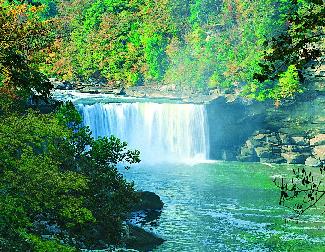A fluid is a material that can flow, like water or air. The kinds of energy that are important to a fluid are kinetic energy (because it can move) and gravitational energy (because it has weight). Water flowing downhill is converting gravitational energy into kinetic energy.
Flow rate is a characterization of how a fluid is moving. We need to distinguish clearly between flow rate and the velocity of the flowing fluid. Watching a leaf floating on a river, we can tell how fast the water is going (in meters per second, for example), while the flow rate is the the number of cubic meters of water that go by you in a second. The flow rate depends on the velocity of the river, but also on how wide and deep it is.

For example, the Mississippi river hardly seems to be moving as it goes by New Orleans -- certainly it is not very exciting -- but it is carrying all the water that went over Cumberland Falls in southern Kentucky (shown in the picture), and far more! The Mississippi River carries 600,000 cubic feet of water past New Orleans every second; the river is 700 feet wide and 200 feet deep, so the water speed is only 5 feet per second. Every second, about 1000 cubic feet of water go over Cumberland Falls, but the falls are not very wide and the river is not very deep, so it is much more exciting.
When we want to move a lot of liquid around, we need a large flow rate; this can be accomplished by having the liquid move very fast (think of the water racing out of the channel at the base of a dam) or by giving it a pipe or channel that is wide and deep.